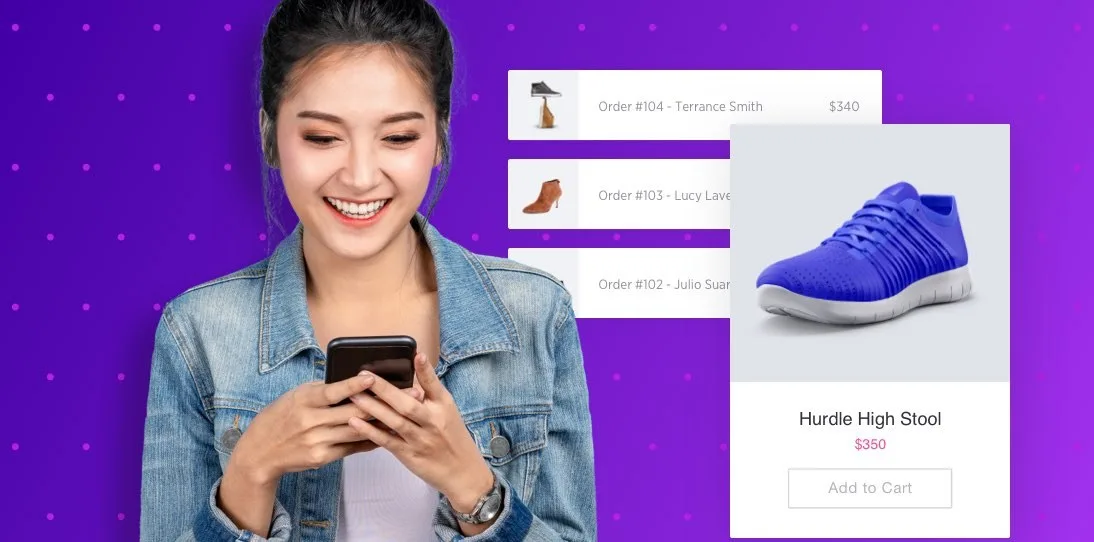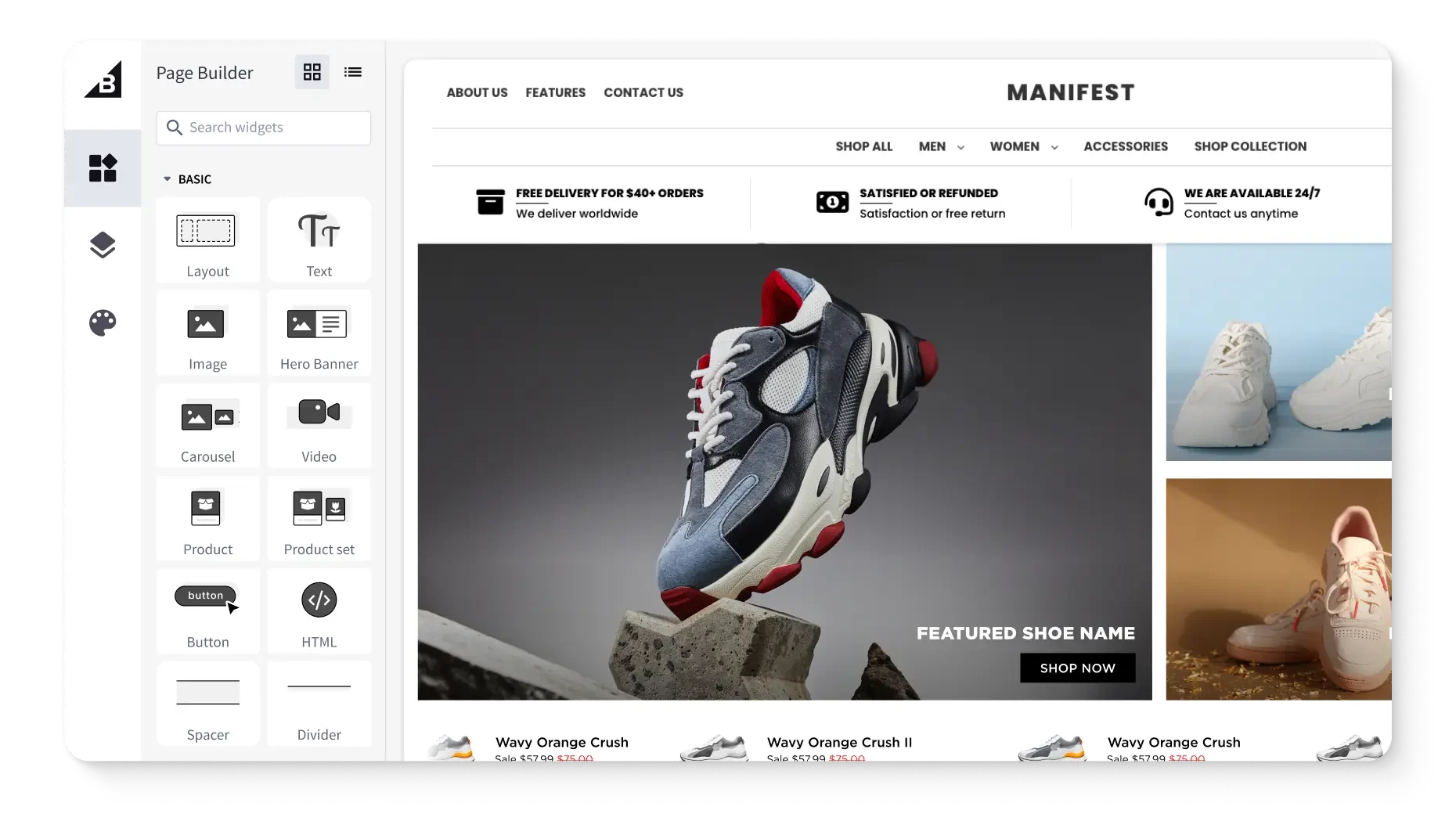The 7 Different Types of Ecommerce Business Models (And How to Choose the Right One)

Written by
Haylee Clark10/16/2025


Types of Ecommerce
Get The Print Version
Tired of scrolling? Download a PDF version for easier offline reading and sharing with coworkers.
A link to download the PDF will arrive in your inbox shortly.
What you’ll learn:
Ecommerce accounts for 23% of retail sales globally in 2025, and it’s expected to reach 25% by 2030 (Statista).
The seven main ecommerce business models: B2C, B2B, B2B2C, B2G, C2B, C2C, and D2C (and the pros, cons, and best-fit scenarios for each).
Value delivery methods — dropshipping, subscriptions, private label, wholesale — shape profitability and scalability.
Future trends like AI personalization, hyperlocalization, and composable commerce.
Choosing an ecommerce business model may sound like a box you check at launch, but it can be much more than that. The model you pick determines:
How you make money
Who your customers are
How you market and fulfill orders
The long-term growth path for your business
Ecommerce continues to outpace traditional retail. In 2025, online sales made up 23% of global retail — a number projected to climb steadily to 25% by 2030. From small D2C brands testing a product idea to enterprise B2B suppliers rethinking decades-old processes, every business needs a model that fits both today’s goals and tomorrow’s ambitions.
So, which type of ecommerce is best for your business? Let’s break it down.

⏰ Isn't about time that you evaluated your ecommerce platform?
Request a demo to see how the BigCommerce platform is different.
The most common types of ecommerce business models
If you’re starting (or scaling) an online business, chances are you’ll fall into at least one of these categories. Each comes with its own benefits, challenges, and “best for” scenarios.
B2C (Business-to-consumer).
B2C businesses sell directly to individual customers through an online platform. Think clothing, groceries, or mobile apps.
Benefits: Shorter sales cycles, broad reach, easier digital marketing.
Drawbacks: Highly competitive, lower average order value, rising customer acquisition costs.
Best for: Small businesses, retail stores, startups, and entrepreneurs testing ideas with low upfront investment.
B2B (Business-to-business).
In a B2B business model, a business sells its product or service to another business, often a manufacturer, wholesaler, or service provider.
Benefits: Higher average order value, recurring revenue, long-term customer relationships.
Drawbacks: Longer sales cycles, reliance on CRM tools, need for personalized engagement.
Best for: Enterprise suppliers, wholesalers, and B2B companies looking to automate sales and strengthen customer relationships.
Ready to replace catalogs and order sheets with an ecommerce storefront? BigCommerce B2B Edition helps companies deliver a buying experience that feels as seamless as B2C.
B2B2C (Business-to-business-to-consumer).
In B2B2C ecommerce, a company, in partnership with another organization, sells its product or service to an end customer.
Benefits: Greater market reach, credibility from established partners, brand awareness.
Drawbacks: Requires brand alignment and trust between businesses, limited control over customer experience, lower profit margin.
Best for: Manufacturers and service providers who want to expand into ecommerce while keeping control of their brand.
B2G (Business-to-government).
Also known as business-to-administration, this model involves selling and marketing products to government agencies or public administrations, whether local, county, state or federal.
This model relies on the successful bidding of government contracts. A government agency will typically put up a request for proposal (RFP) and ecommerce businesses will have to bid on these projects.
Benefits: Secure contracts, stable demand, long-term partnerships.
Drawbacks: Long approval timelines, bureaucratic hurdles, strict regulations, fewer upselling opportunities.
Best for: Manufacturers, distributors, and B2B sellers offering specialized services like infrastructure, IT, energy, or telecom.
C2B (Consumer-to-business).
C2B ecommerce allows individuals to sell goods and services to businesses. Using platforms like Upwork or Fiverr, individuals can monetize their talent or sell products to businesses.
Benefits: Flexibility for individuals, access to diverse and niche talent for businesses.
Drawbacks: Income variability for individuals, quality control for businesses.
Best for: Freelancers, content creators, social media influencers, and consultants.
D2C (Direct-to-consumer).
A direct-to-consumer business sells its own products and services directly to its end customers, without the help of third-party wholesalers or online retailers.
Benefits: Full control over brand and pricing, direct customer relationship, higher margins.
Drawbacks: Higher acquisition costs, need for strong operational logistics and checkout experiences.
Best for: Growing brands that want to own the customer relationship and build loyalty.
C2C (Consumer-to-consumer).
C2C ecommerce platforms — otherwise known as online marketplaces — connect individual buyers and sellers. Websites like Walmart, Alibaba, and eBay pioneered this model in the early days of the internet. Today, Facebook Marketplace, Etsy, and Amazon are some of the big-name online marketplaces.
Benefits: Low barriers to entry, access to a large audience, convenience and lower prices for buyers.
Drawbacks: Quality control issues, high competition, harder to build brand trust.
Best for: Individuals and side-hustlers who want to sell products to a wide market with a low overhead.
What are value delivery methods?
Your business model defines who you sell to, while your value delivery method defines how you sell.
Think of it like this: if your model is the car, your delivery method is the engine that makes it go. And just like choosing the right engine, your choice here can define how fast you scale, how profitable you are, and how strong your brand becomes.
Here are some of the most popular delivery methods in ecommerce today.
White label.
White labeling happens when a business rebrands and sells a generic product under its own name and logo, even though the item itself comes from a third-party manufacturer. It’s especially popular in industries with repeatable products like fashion, skincare, and cosmetics.
Benefits: Low cost of production, fast time-to-market, rapid brand growth without heavy R&D.
Drawbacks: Limited differentiation (your product may look just like competitors’), limited quality control, potential liability for issues with products.
Best for: Retailers that want to enter the market fast, with minimal upfront manufacturing investment.
Private label.
Private label products go a step further. Here, a retailer partners with a manufacturer but controls the product specs, design, packaging, and branding. You outsource production, but the product feels uniquely yours.
Benefits: Brand and price control, higher margins, flexibility to adapt to ecommerce market trends.
Drawbacks: Higher upfront investment, dependence on external manufacturers, longer lead times.
Best for: Brands that want to build high-quality, customized product lines without the cost of manufacturing.
Wholesaling.
Wholesale ecommerce involves selling products in bulk and at a discount to other businesses, acting as the middleman between the manufacturer and retailer.
Benefits: Scalable revenue, cost savings on bulk purchases, high average order value.
Drawbacks: Requires strong logistics, high capital, and deep relationships with buyers.
Best for: B2B companies and brick-and-mortar retailers looking to scale distribution.
Dropshipping.
Dropshipping, one of the fastest-growing methods, involves sellers marketing and selling products fulfilled by a third-party supplier, like AliExpress or Printful. Dropshippers act as a middleman by connecting buyers to manufacturers.
Benefits: No inventory to manage, very low startup costs, and an almost unlimited catalog of products to test.
Drawbacks: Thin profit margins, high competition, and little control over fulfillment speed or product quality.
Best for: Entrepreneurs with limited capital or those testing on-demand product ideas.
Subscription service.
Subscription services are everywhere, from Netflix to meal kits to software. In this model, customers pay on a recurring basis (monthly or annually) for products or services.
Benefits: Predictable recurring revenue, high customer lifetime value, and lower acquisition costs once subscribers are in.
Drawbacks: Requires strong retention strategies and excellent customer reviews to prevent churn.
Best for: Businesses selling consumables, digital goods, or personalized experiences that customers need on a regular basis.
How to select your ecommerce business model
Choosing your ecommerce business model is one of the most strategic moves you’ll make. It will affect how you set prices, fulfill orders, and scale over time. There’s no single “right” model — but there is a model that fits your product, audience, and capabilities.
Here are a few questions to help guide your decision.
What are you selling?
Ecommerce is versatile enough to handle just about anything, but clarity about your product is step one.
Physical products: From books to car parts, physical products dominate ecommerce. But keep in mind they do require inventory management, shipping, and return processes.
Digital goods: eBooks, web design templates, online courses — selling digital goods and products requires almost zero shipping costs and can scale instantly.
Services: Freelancers, consultants, and agencies can now sell services through their own sites, with ecommerce tools making payments and scheduling easy.
Who is your customer?
Your business model depends just as much on your target market as on your product. Knowing who you’re selling to will be the foundation for how you decide things like your marketing approach, pricing, and delivery method.
Consumers (B2C/D2C): Value convenience, reviews, fast checkout, and engaging online platforms.
Businesses (B2B): Look for reliability, bulk pricing, and relationship-driven account management.
Government agencies (B2G): Prioritize compliance, transparency, and detailed proposals.
What are you capable of?
Not every business has the same resources — and that’s okay. What matters is aligning your model with your reality.
Small businesses/startups: Often short on capital and staff. Dropshipping, C2C platforms, or subscriptions are smart entry points because they minimize overhead costs.
Growing brands: May handle their own warehousing and use ecommerce templates with light automation. This makes D2C or private label a strong fit.
Enterprises: With mature fulfillment networks and tech teams, wholesale, B2B, or even headless commerce are natural fits for scaling globally.
What is best for your product?
Depending on what you sell, different models may serve you better than others.
Consumables or repeat purchases: Best paired with subscriptions (think coffee, beauty products, or pet supplies).
Custom or branded items: Thrive in D2C or private label, where brand ownership matters.
Bulk or industrial goods: Naturally align with B2B and wholesale, where large orders and efficiency are key.
Example: A cosmetics company might use D2C to sell directly online while also wholesaling to retail chains.
What is your positioning?
You understand what makes your product better, but will your customer? Think about what sets you apart.
Competing on price? C2C or dropshipping could make sense.
Competing on quality? D2C or private label are better fits.
Competing on convenience? Subscriptions or on-demand fulfillment shine here.
Your unique value proposition should come through not just in marketing, but in the model you choose and the experience you deliver.
Ecommerce business model comparison:
Model | Best for | Customers | Fulfillment | Tech need |
B2C | Small–mid retailers | Consumers | Moderate | Low–medium |
B2B | Mid–enterprise | Businesses | High | Medium–high |
B2B2C | Wholesalers, brands | Businesses + consumers | High | High |
C2B | Freelancers, creators | Businesses | Low | Low–medium |
C2C | Individuals, startups | Peers | Low | Very low |
D2C | Growing brands | Consumers | Moderate-high | Medium |
Emerging trends shaping ecommerce business models
These ecommerce models aren’t static — they evolve with consumer expectations, tech innovation, and market forces. Here’s what’s shaping the future:
AI-driven personalization.
McKinsey research shows that “71% of consumers expect companies to deliver personalized interactions” — not to mention 76% get frustrated when they don’t.
Artificial intelligence (AI) is moving from “nice-to-have” to “non-negotiable” in ecommerce. AI tools can analyze customer data at scale, enabling businesses to deliver hyper-personalized shopping experiences. Think curated product recommendations, tailored discounts, predictive cart reminders, and even AI-powered customer support.
With AI expected to contribute up to $15.7 trillion to the global economy in 2030 (PwC), there’s no excuse for ecommerce businesses to not get in on the action.
Hyper-localization
Two-day shipping used to feel fast. Today, many customers expect same-day or even one-hour delivery for certain items. Hyper-localization is how businesses meet these rising expectations — by building fulfillment closer to where customers live.
In fact, a recent Statista survey found that nearly two-thirds of U.S. consumers would pay extra for “premium delivery.”
Big players like Walmart and Instacart are investing heavily in micro-fulfillment centers and gig-based delivery networks. But smaller ecommerce businesses are also experimenting with local warehouses or partnering with 3PLs to gain similar speed.
Composable and headless commerce
In the past, ecommerce businesses often relied on all-in-one platforms that were rigid and slow to adapt. Composable and headless commerce flips that model. Instead of a monolithic system, companies integrate the “best of breed” tools for each function, such as checkout, CMS, CRM, analytics, etc.
In fact, “80% of retail businesses have already adopted a composable system or are planning to adopt a composable commerce approach” (Dinarys).
Tools like Catalyst from BigCommerce make it easy for teams to launch a new site and build a custom experience that captivates and converts — without all the technical debt.

Get a free 15-day trial of BigCommerce.
No credit cards. No commitment. Explore at your own pace.
The final word
Ecommerce used to be a side channel. Today, it’s the backbone of retail.
Whether you’re a small business testing dropshipping, a B2B company building long-term contracts, or a D2C brand investing in customer relationships, the right model gives you the foundation for growth.
And with BigCommerce, you don’t have to choose between flexibility and power. Our platform helps businesses of every size build smarter, adapt faster, and grow on their own terms.
FAQs for ecommerce business models
B2B2C stands for business-to-business-to-consumer. It’s a hybrid model that combines B2B and B2C by connecting manufacturers, wholesalers, or service providers directly with end customers through a partner business. Instead of relying on an intermediary, the transaction flows seamlessly from the business through the partner to the consumer.
Yes. A hybrid ecommerce site can serve both B2B and B2C audiences without requiring two separate platforms. Many brands already do this. With the right platform, you can segment customer groups, personalize pricing and catalogs, and optimize SEO all under a single domain. This unified approach strengthens brand presence while meeting the needs of both market segments.
Absolutely. Whether you’re a startup, a solopreneur, or a long-established company, any business can set up an ecommerce site. The key is choosing a platform that matches your goals, whether that’s speed to launch, advanced customization, scalability, or low upfront cost. Today’s tools make it possible for businesses of all sizes to transact online.
Historically, B2C ecommerce has been the most visible and financially dominant model because it mirrors traditional retail. However, “success” looks different for every business. For some, it’s maximizing margins; for others, it’s global reach, predictable recurring revenue, or best-in-class customer experience. The most successful model is the one that aligns with your definition of success and your long-term strategy.
When selecting your ecommerce business model, consider these factors:
Your audience: Who you’re selling to (consumers, businesses, or both).
Your product type: Physical goods, digital goods, or services.
Your resources: Inventory, staff, logistics, and technical capacity.
Your market: Competitor landscape, industry trends, and customer expectations.
The best model will play to your strengths while positioning you to grow into new opportunities.
Yes, but it does require careful planning. Many businesses evolve over time — for example, starting with dropshipping and later moving into private label or wholesale. Before making the switch, analyze the impact on your brand, operations, and finances. Communicate clearly with stakeholders, from suppliers to customers, to minimize disruption and ensure a smooth transition.
The ecommerce landscape is evolving quickly, and staying ahead of trends will help future-proof your business model. Some of the most influential trends include:
AI-driven personalization for smarter product recommendations.
Hyper-localization to meet demand for faster delivery.
Composable and headless commerce for more flexible infrastructure.
Social commerce through platforms like TikTok and Instagram.
Digital goods (eBooks, templates, software): Often thrive in D2C or subscription models.
Services (consulting, freelancing): Frequently sold through C2B marketplaces such as Upwork or Fiverr.
Subscriptions (recurring deliveries or memberships): Best for consumables, media, and digital products where long-term customer relationships matter most.
Depending on your audience, reaching customers can look quite different across ecommerce business models:
B2C: Paid ads, influencer marketing, and social commerce on platforms like Instagram and Facebook.
B2B: Account-based marketing, CRM-driven outreach, and long-term relationship building.
C2C: Peer reviews, trust-building, and platform reputation.
Dropshipping or C2C marketplaces are a good starting place, since they require minimal upfront investment, no inventory management, and allow you to test products and audiences with low risk.
Yes — and many businesses do. A cosmetics brand, for example, might sell directly to consumers (D2C), wholesale to retailers (B2B), and offer subscriptions for repeat buyers. With a flexible ecommerce platform, blending models is often the best way to diversify revenue streams and build resilience.

Ebook: How to Stay Ahead in Ecommerce
We surveyed 155 retail executives to see how they're adapting to the ever-changing technology of ecommerce.


